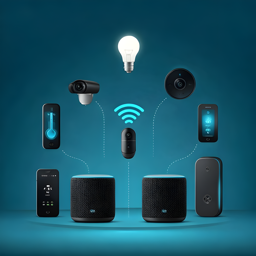ESP32 Coexistence: Master Wi-Fi & BLE Optimization
Mastering ESP32: Rich Architecture & IoT Connectivity
The ESP32 isn’t just another microcontroller Connecting ESP32 to Cloud Services via Wi-FiDiscover how to connect your ESP32 to AWS, Azure, and Google Cloud using secure Wi-Fi. This guide covers setup, error handling, and low power strategies.-it’s a wireless Swiss Army knife for IoT. Its dual-core SoC (System on Chip) and tightly integrated RF subsystems make it a standout choice for developers, offering a perfect balance of performance, connectivity, and power efficiency. This architecture enables the ESP32 to handle everything from battery-powered sensors to industrial gateways with ease. In this article, we’ll explore the ESP32’s architecture in detail, including its dual-core design, integrated RF subsystems, memory architecture, power management
Connecting ESP32 to Cloud Services via Wi-FiDiscover how to connect your ESP32 to AWS, Azure, and Google Cloud using secure Wi-Fi. This guide covers setup, error handling, and low power strategies.-it’s a wireless Swiss Army knife for IoT. Its dual-core SoC (System on Chip) and tightly integrated RF subsystems make it a standout choice for developers, offering a perfect balance of performance, connectivity, and power efficiency. This architecture enables the ESP32 to handle everything from battery-powered sensors to industrial gateways with ease. In this article, we’ll explore the ESP32’s architecture in detail, including its dual-core design, integrated RF subsystems, memory architecture, power management SIM7000G Module with ESP32: Configuring LTE-M and GNSSMaster ESP32 integration with SIM7000G for reliable LTE-M connectivity and precise GPS tracking, featuring hardware setup, AT commands, and power tips., and real-world applications.
SIM7000G Module with ESP32: Configuring LTE-M and GNSSMaster ESP32 integration with SIM7000G for reliable LTE-M connectivity and precise GPS tracking, featuring hardware setup, AT commands, and power tips., and real-world applications.
Table of Contents🔗
- Dual-Core SoC: Power and Efficiency
- Integrated RF Subsystems: Connectivity at Its Core
- Memory Architecture: Speed vs. Persistence
- Power Management
 SIM7000G Module with ESP32: Configuring LTE-M and GNSSMaster ESP32 integration with SIM7000G for reliable LTE-M connectivity and precise GPS tracking, featuring hardware setup, AT commands, and power tips.: From Active to Deep Sleep
SIM7000G Module with ESP32: Configuring LTE-M and GNSSMaster ESP32 integration with SIM7000G for reliable LTE-M connectivity and precise GPS tracking, featuring hardware setup, AT commands, and power tips.: From Active to Deep Sleep - Real-World Use Cases
 Zigbee Green Power: Ultra-Low-Power Energy Harvesting SolutionsDiscover how ZGP enables battery-free IoT devices through energy harvesting with ESP32 integrations, supporting smart home and industrial applications.: Where Architecture Meets Application
Zigbee Green Power: Ultra-Low-Power Energy Harvesting SolutionsDiscover how ZGP enables battery-free IoT devices through energy harvesting with ESP32 integrations, supporting smart home and industrial applications.: Where Architecture Meets Application - Optimizing ESP32 for IoT Projects
 Connecting ESP32 to Cloud Services via Wi-FiDiscover how to connect your ESP32 to AWS, Azure, and Google Cloud using secure Wi-Fi. This guide covers setup, error handling, and low power strategies.
Connecting ESP32 to Cloud Services via Wi-FiDiscover how to connect your ESP32 to AWS, Azure, and Google Cloud using secure Wi-Fi. This guide covers setup, error handling, and low power strategies.
Dual-Core SoC: Power and Efficiency🔗
The ESP32’s Combining Wi-Fi with Deep Sleep for Low-Power ApplicationsLearn how to integrate Wi-Fi and deep sleep on ESP32 to maximize battery life in IoT devices. This guide offers practical tips and step-by-step instructions. Xtensa LX6 dual-core processor (up to 240 MHz) is designed for multitasking and efficiency. Each core can operate independently, enabling developers to distribute tasks for optimal performance and responsiveness.
Combining Wi-Fi with Deep Sleep for Low-Power ApplicationsLearn how to integrate Wi-Fi and deep sleep on ESP32 to maximize battery life in IoT devices. This guide offers practical tips and step-by-step instructions. Xtensa LX6 dual-core processor (up to 240 MHz) is designed for multitasking and efficiency. Each core can operate independently, enabling developers to distribute tasks for optimal performance and responsiveness.
Key Features:
- Asymmetric Multiprocessing (AMP): Dedicate one core to RF stack (Wi-Fi
 Implementing Over-the-Air (OTA) Updates via Wi-Fi on ESP32Learn how to implement secure and reliable OTA updates on ESP32 for enhanced IoT performance, easy updates, and rollback capability without physical access./BT) and the other to application logic.
Implementing Over-the-Air (OTA) Updates via Wi-Fi on ESP32Learn how to implement secure and reliable OTA updates on ESP32 for enhanced IoT performance, easy updates, and rollback capability without physical access./BT) and the other to application logic. - Symmetric Multiprocessing (SMP): Load-balance tasks across both cores using FreeRTOS.
- Ultra-Low-Latency IPC: Shared memory and hardware mutexes for cross-core coordination.
For example, in a smart thermostat, Core 0 can handle temperature algorithms while Core 1 manages encrypted MQTT communication over Wi-Fi-ensuring no packet loss Zigbee Network Diagnostics: Resolving Packet Loss and InterferenceDiscover effective methods to diagnose and resolve packet loss and interference in Zigbee networks using ESP32, ensuring reliable IoT connectivity. during sensor spikes.
Zigbee Network Diagnostics: Resolving Packet Loss and InterferenceDiscover effective methods to diagnose and resolve packet loss and interference in Zigbee networks using ESP32, ensuring reliable IoT connectivity. during sensor spikes.
// FreeRTOS task pinned to Core 0
xTaskCreatePinnedToCore(
sensorTask, // Task function
"Sensor", // Task name
4096, // Stack size
NULL, // Parameters
1, // Priority
NULL, // Task handle
0 // Core 0
);
Integrated RF Subsystems: Connectivity at Its Core🔗
The ESP32’s Combining Wi-Fi with Deep Sleep for Low-Power ApplicationsLearn how to integrate Wi-Fi and deep sleep on ESP32 to maximize battery life in IoT devices. This guide offers practical tips and step-by-step instructions. integrated RF subsystems enable native support for Wi-Fi (2.4 GHz), Bluetooth Classic
Combining Wi-Fi with Deep Sleep for Low-Power ApplicationsLearn how to integrate Wi-Fi and deep sleep on ESP32 to maximize battery life in IoT devices. This guide offers practical tips and step-by-step instructions. integrated RF subsystems enable native support for Wi-Fi (2.4 GHz), Bluetooth Classic Native Protocols: Wi-Fi (2.4 GHz), Bluetooth Classic, and BLEExplore ESP32 connectivity with Wi-Fi, Bluetooth Classic, and BLE. Learn implementation tips and best practices for IoT projects., and Bluetooth Low Energy
Native Protocols: Wi-Fi (2.4 GHz), Bluetooth Classic, and BLEExplore ESP32 connectivity with Wi-Fi, Bluetooth Classic, and BLE. Learn implementation tips and best practices for IoT projects., and Bluetooth Low Energy Native Protocols: Wi-Fi (2.4 GHz), Bluetooth Classic, and BLEExplore ESP32 connectivity with Wi-Fi, Bluetooth Classic, and BLE. Learn implementation tips and best practices for IoT projects. (BLE), making it a versatile choice for wireless communication.
Native Protocols: Wi-Fi (2.4 GHz), Bluetooth Classic, and BLEExplore ESP32 connectivity with Wi-Fi, Bluetooth Classic, and BLE. Learn implementation tips and best practices for IoT projects. (BLE), making it a versatile choice for wireless communication.
Key Features:
- Wi-Fi
 Implementing Over-the-Air (OTA) Updates via Wi-Fi on ESP32Learn how to implement secure and reliable OTA updates on ESP32 for enhanced IoT performance, easy updates, and rollback capability without physical access. Subsystem:
Implementing Over-the-Air (OTA) Updates via Wi-Fi on ESP32Learn how to implement secure and reliable OTA updates on ESP32 for enhanced IoT performance, easy updates, and rollback capability without physical access. Subsystem:
- Supports 802.11 b/g/n standards
 Understanding ESP32 Wi-Fi Capabilities and SpecificationsExplore the ESP32’s Wi-Fi features, technical specs and IoT applications to build smart, scalable, and secure connectivity solutions for every project..
Understanding ESP32 Wi-Fi Capabilities and SpecificationsExplore the ESP32’s Wi-Fi features, technical specs and IoT applications to build smart, scalable, and secure connectivity solutions for every project.. - Operates in Station Mode
 Setting Up Wi-Fi Station Mode on ESP32Master the ESP32 Wi-Fi Station Mode with our guide featuring configuration steps, error handling, and power-saving tips for effective IoT projects., Access Point Mode, or a hybrid of both.
Setting Up Wi-Fi Station Mode on ESP32Master the ESP32 Wi-Fi Station Mode with our guide featuring configuration steps, error handling, and power-saving tips for effective IoT projects., Access Point Mode, or a hybrid of both. - High-speed data transfer and internet connectivity.
- Supports 802.11 b/g/n standards
- Bluetooth Subsystem:
- Supports Bluetooth 4.2 (Classic and BLE
 Native Protocols: Wi-Fi (2.4 GHz), Bluetooth Classic, and BLEExplore ESP32 connectivity with Wi-Fi, Bluetooth Classic, and BLE. Learn implementation tips and best practices for IoT projects.).
Native Protocols: Wi-Fi (2.4 GHz), Bluetooth Classic, and BLEExplore ESP32 connectivity with Wi-Fi, Bluetooth Classic, and BLE. Learn implementation tips and best practices for IoT projects.). - Ideal for short-range
 Quick Comparison: Range, power consumption, costs, and complexity of each technologyDiscover the ideal wireless solution for your ESP32 IoT project by analyzing range, power, cost, and complexity. Optimize connectivity now. communication and low-power applications.
Quick Comparison: Range, power consumption, costs, and complexity of each technologyDiscover the ideal wireless solution for your ESP32 IoT project by analyzing range, power, cost, and complexity. Optimize connectivity now. communication and low-power applications. - Enables pairing with smartphones, wearables, and other Bluetooth-enabled devices.
- Supports Bluetooth 4.2 (Classic and BLE
#include <BLEDevice.h>
BLECharacteristic heartRateChar(
BLEUUID((uint16_t)0x2A37),
BLECharacteristic::PROPERTY_NOTIFY
);
// Configure advertising interval for 1 Hz updates
BLEServer *pServer = BLEDevice::createServer();
pServer->getAdvertising()->setMinInterval(1000);
- Pro tip: Use
esp_wifi_set_ps(WIFI_PS_MIN_MODEM)to reduce Wi-Fi Implementing Over-the-Air (OTA) Updates via Wi-Fi on ESP32Learn how to implement secure and reliable OTA updates on ESP32 for enhanced IoT performance, easy updates, and rollback capability without physical access. power by 30% when BLE is active.
Implementing Over-the-Air (OTA) Updates via Wi-Fi on ESP32Learn how to implement secure and reliable OTA updates on ESP32 for enhanced IoT performance, easy updates, and rollback capability without physical access. power by 30% when BLE is active.
Memory Architecture: Speed vs. Persistence🔗
The ESP32’s Combining Wi-Fi with Deep Sleep for Low-Power ApplicationsLearn how to integrate Wi-Fi and deep sleep on ESP32 to maximize battery life in IoT devices. This guide offers practical tips and step-by-step instructions. memory architecture is optimized for both speed and persistence, ensuring efficient data handling and storage.
Combining Wi-Fi with Deep Sleep for Low-Power ApplicationsLearn how to integrate Wi-Fi and deep sleep on ESP32 to maximize battery life in IoT devices. This guide offers practical tips and step-by-step instructions. memory architecture is optimized for both speed and persistence, ensuring efficient data handling and storage.
Memory Hierarchy:
1. 520KB SRAM (Fast, volatile):
- Split into 328KB DRAM (data) and 192KB IRAM (instructions).
- Critical for time-sensitive RF operations.
2. 4MB Flash (Slow, persistent):
- XIP (Execute In Place) allows running code directly from flash.
- Wear-leveling extends lifespan to 100k+ write cycles.
3. 8KB RTC Memory (Ultra-low-power):
- Retains data during deep sleep
 LTE Power Saving: Combining PSM and DRX with ESP32 Sleep ModesDiscover how combining LTE power-saving modes with ESP32 sleep techniques can extend battery life in IoT devices while ensuring reliable connectivity. (current: ~1μA).
LTE Power Saving: Combining PSM and DRX with ESP32 Sleep ModesDiscover how combining LTE power-saving modes with ESP32 sleep techniques can extend battery life in IoT devices while ensuring reliable connectivity. (current: ~1μA).
Memory Map Conflicts Example:
// Bad practice - IRAM overflow causes Wi-Fi crashes
void IRAM_ATTR sensorISR() {
// ISR code here
}
// Solution: Move non-critical code to DRAM
Power Management: From Active to Deep Sleep🔗
The ESP32’s power management is a cornerstone of its efficiency, offering multiple modes to balance performance and energy consumption Quick Comparison: Range, power consumption, costs, and complexity of each technologyDiscover the ideal wireless solution for your ESP32 IoT project by analyzing range, power, cost, and complexity. Optimize connectivity now..
Quick Comparison: Range, power consumption, costs, and complexity of each technologyDiscover the ideal wireless solution for your ESP32 IoT project by analyzing range, power, cost, and complexity. Optimize connectivity now..
| Mode | Current | Wake-up Time | Retained Memory |
|---|---|---|---|
| Active | 100 mA | Instant | All |
| Modem-sleep | 15 mA | 3 ms | Wi-Fi state |
| Light-sleep | 0.8 mA | 5 ms | RTC |
| Deep-sleep | 5 μA | 100 ms | RTC + 8KB |
#define TOUCH_THRESHOLD 40
void setup() {
esp_sleep_enable_touchpad_wakeup();
touch_pad_set_thresh(TOUCH_PAD_NUM8, TOUCH_THRESHOLD);
esp_deep_sleep_start();
}
- Industrial application: A vibration sensor wakes every 15 minutes via timer, samples for 2 seconds, then sleeps-achieving a 10-year battery life
 Cost Analysis: Total Ownership for ESP32 Connectivity SolutionsUnlock cost savings with ESP32 IoT solutions. This guide reveals how to balance hardware, connectivity, power, and maintenance costs to master TCO..
Cost Analysis: Total Ownership for ESP32 Connectivity SolutionsUnlock cost savings with ESP32 IoT solutions. This guide reveals how to balance hardware, connectivity, power, and maintenance costs to master TCO..
Real-World Use Cases: Where Architecture Meets Application🔗
The ESP32’s architecture makes it suitable for a wide range of IoT applications Connecting ESP32 to Cloud Services via Wi-FiDiscover how to connect your ESP32 to AWS, Azure, and Google Cloud using secure Wi-Fi. This guide covers setup, error handling, and low power strategies.:
Connecting ESP32 to Cloud Services via Wi-FiDiscover how to connect your ESP32 to AWS, Azure, and Google Cloud using secure Wi-Fi. This guide covers setup, error handling, and low power strategies.:
1. Smart Home Hub
- Core 0: Z-Wave/Zigbee
 Interfacing ESP32 with Zigbee3.0 Devices (Xiaomi, Philips Hue)Unlock seamless smart home integration by following our detailed guide on bridging ESP32 with external Zigbee modules for reliable IoT solutions. bridge via UART.
Interfacing ESP32 with Zigbee3.0 Devices (Xiaomi, Philips Hue)Unlock seamless smart home integration by following our detailed guide on bridging ESP32 with external Zigbee modules for reliable IoT solutions. bridge via UART. - Core 1: Wi-Fi MQTT broker
 Connecting ESP32 to Cloud Services via Wi-FiDiscover how to connect your ESP32 to AWS, Azure, and Google Cloud using secure Wi-Fi. This guide covers setup, error handling, and low power strategies. with TLS.
Connecting ESP32 to Cloud Services via Wi-FiDiscover how to connect your ESP32 to AWS, Azure, and Google Cloud using secure Wi-Fi. This guide covers setup, error handling, and low power strategies. with TLS. - RF: Concurrent BLE beacons
 Using BLE Beacons with ESP32 for Location TrackingLearn the fundamentals of BLE beacons by mastering ESP32 configuration for indoor navigation, asset tracking and efficient location monitoring. for presence detection.
Using BLE Beacons with ESP32 for Location TrackingLearn the fundamentals of BLE beacons by mastering ESP32 configuration for indoor navigation, asset tracking and efficient location monitoring. for presence detection.
2. Industrial Sensor Node
- SRAM buffers sensor data
 Sigfox Message Encoding: Packing Sensor Data into 12-byte PayloadsLearn efficient data encoding techniques for Sigfox's constrained 12-byte payloads. Discover bitwise operations, structured encoding & CBOR strategies. during LoRaWAN uplinks.
Sigfox Message Encoding: Packing Sensor Data into 12-byte PayloadsLearn efficient data encoding techniques for Sigfox's constrained 12-byte payloads. Discover bitwise operations, structured encoding & CBOR strategies. during LoRaWAN uplinks. - RTC memory stores hourly aggregates during outages.
- Light-sleep between 30-minute reporting intervals.
3. Wearable Health Monitor
- BLE
 Native Protocols: Wi-Fi (2.4 GHz), Bluetooth Classic, and BLEExplore ESP32 connectivity with Wi-Fi, Bluetooth Classic, and BLE. Learn implementation tips and best practices for IoT projects. advertising optimized for 1 Hz heart rate updates.
Native Protocols: Wi-Fi (2.4 GHz), Bluetooth Classic, and BLEExplore ESP32 connectivity with Wi-Fi, Bluetooth Classic, and BLE. Learn implementation tips and best practices for IoT projects. advertising optimized for 1 Hz heart rate updates. - Dedicated hardware AES
 NFC Security: Implementing Encryption and Tamper DetectionLearn how to secure your ESP32 NFC projects with AES encryption, HMAC validation, and tamper detection techniques for robust wireless security. encrypts ECG data pre-transmission.
NFC Security: Implementing Encryption and Tamper DetectionLearn how to secure your ESP32 NFC projects with AES encryption, HMAC validation, and tamper detection techniques for robust wireless security. encrypts ECG data pre-transmission. - Touch wakeup eliminates physical buttons.
Optimizing ESP32 for IoT Projects🔗
To maximize the ESP32’s Combining Wi-Fi with Deep Sleep for Low-Power ApplicationsLearn how to integrate Wi-Fi and deep sleep on ESP32 to maximize battery life in IoT devices. This guide offers practical tips and step-by-step instructions. potential, follow these tips:
Combining Wi-Fi with Deep Sleep for Low-Power ApplicationsLearn how to integrate Wi-Fi and deep sleep on ESP32 to maximize battery life in IoT devices. This guide offers practical tips and step-by-step instructions. potential, follow these tips:
- Power Management
 SIM7000G Module with ESP32: Configuring LTE-M and GNSSMaster ESP32 integration with SIM7000G for reliable LTE-M connectivity and precise GPS tracking, featuring hardware setup, AT commands, and power tips.: Use Deep Sleep Mode
SIM7000G Module with ESP32: Configuring LTE-M and GNSSMaster ESP32 integration with SIM7000G for reliable LTE-M connectivity and precise GPS tracking, featuring hardware setup, AT commands, and power tips.: Use Deep Sleep Mode SIM7000G Module with ESP32: Configuring LTE-M and GNSSMaster ESP32 integration with SIM7000G for reliable LTE-M connectivity and precise GPS tracking, featuring hardware setup, AT commands, and power tips. to conserve energy in battery-powered devices.
SIM7000G Module with ESP32: Configuring LTE-M and GNSSMaster ESP32 integration with SIM7000G for reliable LTE-M connectivity and precise GPS tracking, featuring hardware setup, AT commands, and power tips. to conserve energy in battery-powered devices. - Task Prioritization: Assign high-priority tasks to one core and background tasks to the other.
- RF Optimization: Tune Wi-Fi and Bluetooth settings to minimize interference
 Zigbee Network Diagnostics: Resolving Packet Loss and InterferenceDiscover effective methods to diagnose and resolve packet loss and interference in Zigbee networks using ESP32, ensuring reliable IoT connectivity. and maximize range.
Zigbee Network Diagnostics: Resolving Packet Loss and InterferenceDiscover effective methods to diagnose and resolve packet loss and interference in Zigbee networks using ESP32, ensuring reliable IoT connectivity. and maximize range.
By leveraging the ESP32’s architecture effectively, you can create efficient, scalable, and robust IoT solutions Connecting ESP32 to Cloud Services via Wi-FiDiscover how to connect your ESP32 to AWS, Azure, and Google Cloud using secure Wi-Fi. This guide covers setup, error handling, and low power strategies..
Connecting ESP32 to Cloud Services via Wi-FiDiscover how to connect your ESP32 to AWS, Azure, and Google Cloud using secure Wi-Fi. This guide covers setup, error handling, and low power strategies..
The ESP32’s Combining Wi-Fi with Deep Sleep for Low-Power ApplicationsLearn how to integrate Wi-Fi and deep sleep on ESP32 to maximize battery life in IoT devices. This guide offers practical tips and step-by-step instructions. dual-core SoC and integrated RF subsystems make it a standout choice for IoT developers. Whether you’re building a smart home device, a wearable, or an industrial monitoring system, the ESP32 provides the power, flexibility, and connectivity you need to bring your ideas to life. Its architecture isn’t just about raw specs-it’s about orchestrating compute, connectivity, and power into IoT solutions
Combining Wi-Fi with Deep Sleep for Low-Power ApplicationsLearn how to integrate Wi-Fi and deep sleep on ESP32 to maximize battery life in IoT devices. This guide offers practical tips and step-by-step instructions. dual-core SoC and integrated RF subsystems make it a standout choice for IoT developers. Whether you’re building a smart home device, a wearable, or an industrial monitoring system, the ESP32 provides the power, flexibility, and connectivity you need to bring your ideas to life. Its architecture isn’t just about raw specs-it’s about orchestrating compute, connectivity, and power into IoT solutions Connecting ESP32 to Cloud Services via Wi-FiDiscover how to connect your ESP32 to AWS, Azure, and Google Cloud using secure Wi-Fi. This guide covers setup, error handling, and low power strategies. that just work.
Connecting ESP32 to Cloud Services via Wi-FiDiscover how to connect your ESP32 to AWS, Azure, and Google Cloud using secure Wi-Fi. This guide covers setup, error handling, and low power strategies. that just work.
Author: Marcelo V. Souza - Engenheiro de Sistemas e Entusiasta em IoT e Desenvolvimento de Software, com foco em inovação tecnológica.
References🔗
- Arduino Forum: forum.arduino.cc
- Arduino IDE Official Website: arduino.cc
- ESP-IDF Programming Guide: docs.espressif.com/projects/esp-idf
- ESP32 Arduino Core Documentation: docs.espressif.com/projects/arduino-esp32
- Espressif Documentation: docs.espressif.com
 7 months ago
7 months ago
 7 months ago
7 months ago
 8 months ago
8 months ago
 7 months ago
7 months ago
 7 months ago
7 months ago
 8 months ago
8 months ago
 5 months ago
5 months ago
 8 months ago
8 months ago
 7 months ago
7 months ago
 7 months ago
7 months ago
 7 months ago
7 months ago
 7 months ago
7 months ago
 7 months ago
7 months ago
 7 months ago
7 months ago
 7 months ago
7 months ago
 7 months ago
7 months ago
 7 months ago
7 months ago
 7 months ago
7 months ago
 7 months ago
7 months ago
 7 months ago
7 months ago
 7 months ago
7 months ago